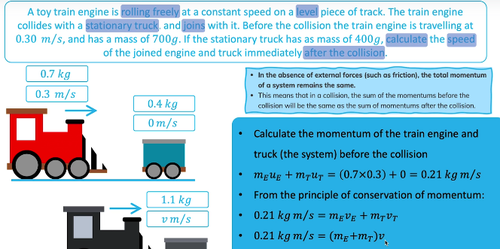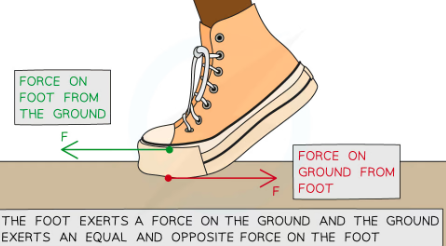momentum
1/26
There's no tags or description
Looks like no tags are added yet.
Name | Mastery | Learn | Test | Matching | Spaced |
|---|
No study sessions yet.
27 Terms
what is momentum?
it is the product of mass and velocity. an object with mass that is in motion has momentum. It is a vector. It can be either positive or negative. Measure of how difficult it is to stop something that is moving
momentum equation
momentum= mass x velocity
P=mv
p = momentum in kilogram metre per second (kg m/s)
m = mass in kilograms (kg)
v = velocity in metres per second (m/s)
momentum affect on direction
an object at rest (i.e v = 0) has no momentum.
Momentum keeps an object moving in the same direction, making it difficult to change the direction of an object with a large momentum
what does momentum of obejct depend on
Since velocity is a vector this means that the momentum of an object also depends on its direction of travel This means that momentum can be either positive or negativeIf an object travelling to the right has positive momentum, an object travelling in the opposite direction (to the left) will have negative momentum
when will momentum of object change
-The object accelerates (speeds up) or decelerates (slows down)
-Changes direction-since moemntum is a vector quantity
-Its mass changes. The greater the mass of an object the greater its velocity so mroe momentum it has
what si principle of conservation of momentum?
In a closed system, the total momentum before an event is equal to the total momentum after the event (if no (external) unbalanced force acts)
m1 v1 = m2 v2
what happens to momentum when objects moving in opposite directions
Since momentum is a vector quantity, a system of objects moving in opposite (e.g. towards each other) at the same speed will have an overall momentum of 0 since they will cancel out

why is momentum used in safety features?
Since force x time is equal to the rate of change in momentum the force of an impact in a vehicle collision can be decreased by increasing the contact time over whch teh collision occurs. short time and therefore a large force is produced. If time is increased then for the same change in momentum the force is smaller.
how safety features in car use momentum
Vehicle safety features are designed to absorb energy upon an impact by changing shape
The main vehicle safety features are crumple zones, seat belts and airbags
For a given force upon impact, these absorb the energy from the impact and increase the time over which the force takes place.This increases the time taken for the change in momentum of the passenger and the vehicle to come to rest. The increased time reduces the force and risk of injury on a passenger
what does usefulness of safety features depend on?
The usefulness of safety equipment depends on two main factors: mass and velocity
If the impact is from a large mass, for example, a truck travelling very fast and colliding with a wall, the momentum will be very large
The change in momentum (ie. from a high speed to rest) will also be very large
This means that a very long contact time is needed to reduce the force of impact
what is a crumple zone
A crumple zone is an exterior area of a vehicle (usually located in the front and rear) that’s designed
to crumple or crush in a controlled way in a collison. This icnreases time over which the vehicle comes to a rest so lowering the impact force on the passenger.
what is a seatbelt
A seatbelt prevents people from being thrown forward during an abrupt by keeping them fixed ot their seats. They are designed ot have enough ‘give’ to allow the passenger to move forward slightly and so increase the time for the passenger’s momentum to reach zero and reduce the force on them in a collision. If no seat belt they will continue moving forward until they hit smt.
how does an airbag work?
These are deployed at the front on the dashboard and steering wheel when a collision occurs. An airbag is a vehicle occupant restraint system using a bag designed to inflate extremely
rapidly then quickly deflate during a collision.They act as a soft cushion to prevent injury on the passenger when they are thrown forward upon impact
how do crash mats work?
Crash mats used in gymnasiums help reduce the risk of injury for falls in gymnastics and climbing. They are thick and soft to offer shock absorption of the force created by the person landing on the mat. When a person lands on a crash mat with a large force, for example after jumping, the soft landing means their body is in contact with the mat for a longer period of time than if it was otherwise not there.This increases the contact time over which their momentum is reduced creating a smaller impact force and a lower chance of injury
when are thinner crash matts used?
If used in a playground for children as they have a lower mass. Or when fall with low velocity eg lower heights
whta equation to use if joint momentum/velocity
total momentum= (m1+m2) v
momentum before vs after=
m x v= (m1+m2) v

momentum of an object before and after collision
Before the collision:
The momentum is only of mass m which is moving
If the right is taken as the positive direction, the total momentum of the system is m × u
After the collision:Mass M also now has momentum
The velocity of m is now -v (since it is now travelling to the left) and the velocity of M is V
The total momentum is now the momentum of M + momentum of m
This is (M × V) + (m × -v) or (M × V) – (m × v)

what is impulse
it is a certain amountof force you apply for a certain amount of time to ause a change in momentum, It is equal to change in momentum.
impulse = force × change in time
impulse = FΔt
impulse = F x Δt = Δp (ft) = mv − mu
what is force in terms of momentum?
Force is the rate of change in momentum.
F = mv-mu/t same as F=ma (a=v/t)
Δt is the change in time, or the time taken for the force to change

equation for change in momentum
Δp = Δ(mv)
Δp = mv − mu
Where:m = mass in kg
v = final velocity in m/s
u = initial velocity in m/s
example of impulse-raina nd hail
An example in everyday life of impulse is when standing under an umbrella when it is raining, compared to hail (frozen water droplets) When rain hits an umbrella, the water droplets tend to splatter and fall off it and there is only a very small change in momentum However, hailstones have a larger mass and tend to bounce back off the umbrella, creating a greater change in momentum.Therefore, the impulse on an umbrella is greater in hail than in rainThis means that more force is required to hold an umbrella upright in hail compared to rain
how many newtons in 1 kg
1kg= 9.8 newtons
equation linking force an dchnage in momentum
force is rate of change in monetum
force= chnage in momentum/change in time
what is newtons third law?
Whenever two bodies interact, the forces they exert on each other are equal and opposite. Every action has an equal and opposite reaction
However, it is important to remember that the two forces:
-act on two different objects
-are of the same type (eg both contact forces)
For every force object A exerts on object B, object B will exert an equal and opposite force on object A.
There is always only 2 objects involved.
what does newtons third alw explain?
According to Newton's third law of motion, whenever two objects interact, they exert equal and opposite forces on each other. It explains where the unbalanced force reuired to make an object accelerate comes from. It shows that all forces come in pairs if object A exerts a force on object B, then object B exerts an equal and opposite force on object A. Also shwos that force pairs are of the same type - for example, if object A exerts a gravitational force on object B, then object B exerts an equal and opposite gravitational force on object A. It also explains that when two objects collide, both objects will react, generally causing one object to speed up (gain momentum) and the other object to slow down (lose momentum)
how do you walk in terms of newtons third law?
One force is from the foot that pushes the ground backwards.The other is an equal and opposite force from the ground that pushes the foot forwards. Stops your foot from sinking into ground

Use Newton’s laws to explain the motion of a rocket as it is launched from Earth until it reaches a constant speed orbiting the Earth.
Initially the forces acting on the rocket are balanced as the weight of the rocket is equal to the reaction force from the ground (N1). The engines are switched on and fuel is burned. As the fuel burns, the force exerted on the ground increases so the thrust increases causing it to travel upwards. The spacecraft gains an equal amoutn of momentum in th eopposite direction to that of the moving exhaust fumes.
